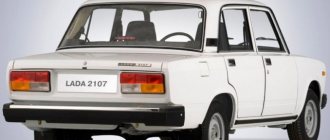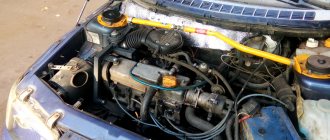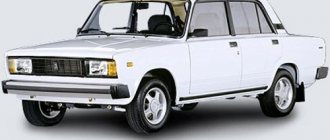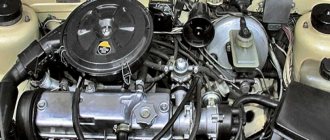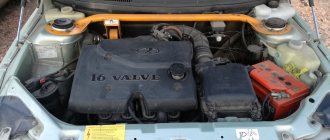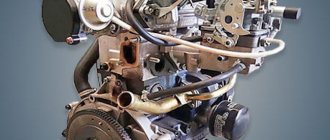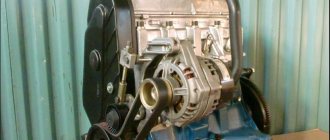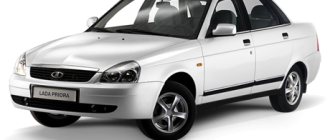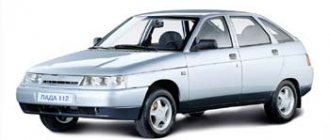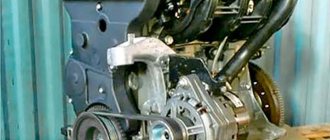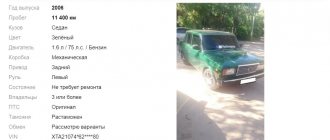Benefits obtained by tuning an injection engine
Tuning the injector helps to unlock the full potential of the car engine. The improvement in engine performance is due to the following factors:
- portions of supplied fuel become more accurately dosed and depend on the engine operating mode;
- reducing the proportion of unburned gasoline in the exhaust leads to a decrease in environmental pollution;
- increasing the speed of reaction to pressing the gas pedal;
- Sensitivity to engine load allows you to supply the optimal amount of fuel;
- increasing engine efficiency as a result of complete combustion of a portion of the supplied fuel;
- as a result of flashing the electronic control unit, you can get rid of initially uncorrected bugs;
- all changes made to the electronic module are completely reversible;
- idle speed becomes more stable and less dependent on ambient temperature.
Typically, injector tuning is accompanied by an increase in engine power of up to 20 horsepower. If the main goal of tuning is to increase the efficiency of the car, then such a significant increase in horses is not observed. The recommended golden mean for the changes made is the maximum improvement in dynamic characteristics, accompanied by an acceptable increase in fuel consumption.
Characteristics of VAZ 2107
| Performance indicators | Meaning |
| Maximum speed, km/h | 150 |
| Fuel consumption l: | |
| City | 9,6 |
| Route | 6,9 |
| Mixed | 8 |
| Euro toxicity standard | Euro 2 |
| Engine | |
| Power unit volume, cm3 | 1451 |
| Fuel type | petrol |
| Number and arrangement of cylinders | 4/R |
| Supply system | Distributive injection |
| Number of valves | 8 |
| Maximum torque, N*m at rpm | 115 at 3450 |
| Maximum power, hp | 71 |
| Transmission | |
| Transmission type | Mechanical |
| Number of steps | 5 |
| type of drive | Rear |
| Suspension | |
| Front suspension device | Independent multi-link |
| Rear suspension device | Dependent, on coil springs |
| Front brake mechanism | Disk |
| Rear brake mechanism | Drum |
Initially, the seven was equipped with an engine with a capacity of 1.5 liters, but during the production process the power range was expanded.
Modifications of engines installed on the VAZ 2107.
| Options | Model range of VAZ engines | ||||
| 2103 | 2104 | 2106 | 21067 | 21067-20 | |
| Cylinder diameter, piston stroke | 76 80 | 76 80 | 79 80 | 79 80 | 79 20 |
| Working volume | 1,5 | 1,5 | 1,6 | 1,6 | 1,6 |
| Compression ratio | 8,5 | 8,5 | 8,5 | 8,5 | 8,5 |
| Supply system | carburetor | Distributive injection | carburetor | Distributive injection | Distributive injection |
| Rated power, kW | 52,5 | 52,5 | 54,8 | 54,5 | 53,5 |
| Rated speed | 5600 | 5000 | 5600 | 5000 | 5300 |
| Fuel brand | (AI-92) | (AI-92) | (AI-92) | (AI-92) | (AI-95) |
| Spark plug | A17DVR, FE65CPR, A17DV-10 | А17ДВРМ, BRISR, SUPER, LR 15YC | A17DVR, FE65CPR, A17DV-10 | А17ДВРМ, BRISR, SUPER, LR 15YC | А17ДВРМ, BRISR, SUPER, LR 15YC |
| Toxicity standard | Euro-0 | Euro 2 | Euro-0 | Euro 2 | Euro-3 |
Total information
| Options | VAZ 2107 | VAZ 21074 | VAZ 2107-20 | VAZ 21074-20 |
| Weight of the equipped vehicle, kg | 1060 | 1060 | 1060 | 1060 |
| Payload, kg | 400 | 400 | 400 | 400 |
| Permitted maximum weight, kg | 1460 | 1460 | 1460 | 1460 |
| Ground clearance of a vehicle with a permissible maximum weight, with tires 175/70 R13, not less, mm: | ||||
| to the front suspension cross member | 162 | 162 | 162 | 159 |
| to the rear axle beam | 157 | 157 | 157 | 154 |
| Permissible weight of cargo on the additional (top) luggage rack, kg | 50 | 50 | 50 | 50 |
| Maximum speed, km/h: | ||||
| with permissible maximum weight | 148 | 148 | — | — |
| with driver and passenger | 150 | 150 | 150 | 150 |
| Acceleration time from standstill to 100 km/h, s: | ||||
| with driver and one passenger | 17 | 16 | 17 | 16 |
| with permissible maximum weight | 19 | 17,5 | — | — |
| Minimum turning radius along the track of the outer front wheel, m | 5,6 | 5,6 | 5,6 | 5,6 |
| The greatest rise overcome by a car with a permissible maximum weight without acceleration in first gear, % | 36 | 36 | 36 | 36 |
Characteristics and principle of operation of the engine
The operation of the fuel injection system is to supply fuel separately to each cylinder. This mechanism is called distributor injection. All modern cars are equipped with a distribution or electronic injection system.
The injection mechanism is classified according to its operating principle, installation location and number of injectors. “Seven” is equipped with 4 nozzles, which are controlled by an electronic control unit. The ECU prepares the mixture depending on the engine load, throttle position and other parameters read by special modules.
The main control element of the VAZ 21074 injector is an electronic control unit. Using built-in sensors, the ECU monitors the quality of the air-fuel mixture supplied to the combustion chamber, sets the ignition timing depending on the speed, and turns the fuel pump on and off. In addition, it regulates the idle speed, controls the emission of CO in the exhaust gases and determines the operating mode of the cooling fan.
The VAZ 21074 injector works in the following order.
The pump supplies fuel from the gas tank through filters to the fuel rail. Next, the fuel is supplied to the injectors. The pressure in the injectors is maintained by a special regulator within 300 MPa. Excess fuel is sent back to the tank. The injector is a sprayer with a solenoid valve, which operates from ECU pulses.
By reading readings from the piston position module in the cylinder, the central unit determines the moment of opening and closing of the injector. The optimal quality of the air-fuel mixture is prepared based on the readings of the mass air flow sensor and the throttle position.
Other parameters are also taken into account:
- cooling system temperature - necessary to determine the degree of engine warm-up and adjust idle speed. The temperature correction affects the degree of richness of the mixture;
- oxygen concentration - used to measure the oxygen content in exhaust gases;
- on-board network voltages - read by the speed sensor to transmit pulses in a certain order.
Characteristics and principle of operation of the engine
The operation of the fuel injection system is to supply fuel separately to each cylinder. This mechanism is called distributor injection. All modern cars are equipped with a distribution or electronic injection system.
The injection mechanism is classified according to its operating principle, installation location and number of injectors. “Seven” is equipped with 4 nozzles, which are controlled by an electronic control unit. The ECU prepares the mixture depending on the engine load, throttle position and other parameters read by special modules.
The main control element of the VAZ 21074 injector is an electronic control unit. Using built-in sensors, the ECU monitors the quality of the air-fuel mixture supplied to the combustion chamber, sets the ignition timing depending on the speed, and turns the fuel pump on and off. In addition, it regulates the idle speed, controls the emission of CO in the exhaust gases and determines the operating mode of the cooling fan.
The VAZ 21074 injector works in the following order.
The pump supplies fuel from the gas tank through filters to the fuel rail. Next, the fuel is supplied to the injectors. The pressure in the injectors is maintained by a special regulator within 300 MPa. Excess fuel is sent back to the tank. The injector is a sprayer with a solenoid valve, which operates from ECU pulses.
By reading readings from the piston position module in the cylinder, the central unit determines the moment of opening and closing of the injector. The optimal quality of the air-fuel mixture is prepared based on the readings of the mass air flow sensor and the throttle position.
Other parameters are also taken into account:
- cooling system temperature - necessary to determine the degree of engine warm-up and adjust idle speed. The temperature correction affects the degree of richness of the mixture;
- oxygen concentration - used to measure the oxygen content in exhaust gases;
- on-board network voltages - read by the speed sensor to transmit pulses in a certain order.
Malfunctions of the engine with distributed injection
In any mechanism during its operation, certain breakdowns occur. The injection engine of the “Seven” is not immune from this. There are many faults and they are different, let’s look at the main, most common ones:
- unstable and unstable operation of the engine without load;
- clogged injectors;
- increased gasoline consumption;
- the permissible norm of CO2 in exhaust gases has been exceeded;
- when the throttle valve is opened sharply, dips in engine speed are formed;
- the power plant does not “pull”, power decreases.
To correct these defects, it is better to contact a specialized workshop. Specialists will carry out diagnostics using a computer with a specific program. They will determine the causes of failures, check whether the sensor readings are correct or not, and evaluate the operation of the ECU. After this, the necessary repairs will be carried out using equipment.
Tuning
And in conclusion, I would like to say about tuning the VAZ 2110 engine.
In the VAZ 2110, engine tuning is very easy to do. To do this, you only need a tool and a room. This process can be done not only in a specialized workshop, but also in your garage.
Tuning a VAZ 2110 engine requires only a set of tools and patience:
- The first step is to simply replace the camshaft with a better one. Due to this, power will increase and engine performance will improve.
- You can also install a new crankshaft to increase the volume of the unit. If this is not done, then further tuning of the VAZ 2110 engine will be in vain.
- The installation of a compressor is quite simple. This unit allows you to increase power and get good torque.
- It is worth noting that tuning the VAZ 2110 engine can be done by anyone. This does not require special experience or skills. It is enough to know the structure of the car and have locksmith skills. Experts recommend installing a high-quality stock piston so that it can withstand about 0.5 bar.
We make changes to the engine design
A significant increase in power can be achieved by modifying the engine of the VAZ-2106 car, which requires experience and the implementation of a whole range of measures:
First we bore the cylinders so that their diameter is 82 millimeters. In addition, we reduce the length of the piston skirt by a few millimeters
At this stage, it is important not to overdo it so as not to spoil the parts; after this we install connecting rods and a flywheel made of light metal alloys; the next stage is milling the cylinder head. You will need to remove no more than one millimeter to achieve the desired effect; grinding intake and exhaust manifolds
This procedure will reduce the resistance to the air-fuel mixture, which will automatically increase the power of the power unit; installation of the electronic ignition system already mentioned above; installation of a new distributor equipped with a Hall sensor; installation of a tube in the exhaust manifold that will connect it directly to the intake manifold.
In order to get the desired effect after all the steps described above, it is better to use molybdenum oil (or a lubricant with molybdenum additives). You will also need to fill the tank with A-95 or A-98 gasoline. If these conditions are met, the power increases to 110 horsepower.
The increased power characteristics of the VAZ-2106 will require flawless operation of the braking system and suspension, so a number of changes will need to be made to them. At the last stage, the gearbox is also modernized, ensuring the most comfortable control of the car.
Transmission
| Clutch | single-disk, dry, with hydraulic shutdown drive and central diaphragm spring | |||
| Transmission | mechanical, four- or five-speed, three-way, three-shaft, with synchronizers on all forward gears | |||
| Gear ratios: | ||||
| first | 3,67 | |||
| second | 2,10 | |||
| third | 1,36 | |||
| fourth | 1,0 | |||
| fifth | 0,82 | |||
| reverse | 3,53 | |||
| Cardan transmission | two-shaft, with intermediate support and elastic coupling | |||
| main gear | hypoid | |||
| Final drive ratio | gear ratio - 3.9 or 4.1 | |||
| Differential | conical, two-satellite | |||
Problems with the DAAZ 2107 carburetor
Despite the fact that the device is reliable and durable, units that are more than 30 years old are also in use today. During such a period of use, the likelihood that the car owner will encounter various kinds of problems is quite high.
What malfunctions are typical for Dimitrovgrad-made carburetors:
The engine stalls when you press the gas
At the moment of start or when idling, the power unit may stall when the driver smoothly presses the pedal.
Why does this happen:
- The holes in the transition system of chamber 1 may become clogged. They need to be blown out or treated with a cleaner.
- The accelerator pump is broken. It is replaced or repaired.
It is also possible that when moving while gas is supplied, the engine jerks and may stop. To prevent this, you urgently need to press the pedal again.
What does this mean:
- The channels, jets or emulsion well are clogged. The defect can be eliminated by cleaning the elements.
- The nozzle of the dosing system of chamber 1 is not screwed in completely. It needs to be wrapped.
- The jets are not selected correctly.
- The fuel level in the float chamber is insufficient, which is regulated by setting the float and valve.
- The filter installed at the inlet is dirty. It needs to be dismantled and cleaned.
- Poor condition of sealing elements that need to be replaced.
The ignition system may also be faulty.
Pouring gasoline
This problem is encountered quite often. Usually it lies in a malfunction of the metering units or the vehicle’s fuel system.
- malfunction or leakage of the needle valve;
- leakage or breakdown of the float;
- the float touches the walls when moving around the chamber;
- the fuel level in the float chamber is exceeded;
- the jets supplying air are clogged;
- fuel pump failure.
Knowing the design of the carburetor, it is not difficult to find the source of the problem.
Shoots
The power unit may shoot into the carburetor. Such pops can be heard both at start and when moving at speed. This leads to high fuel consumption, engine overheating, unstable idling, and also to the fact that the engine cannot develop full power. Shooting indicates improper adjustment of the fuel-air mixture preparation and gas distribution system.
Gasoline is not supplied
If fuel does not flow into the carburetor, there can be many reasons.
Main sources of problems:
- fuel filter contamination;
- ice formation in the gas pipeline;
- leaks at fuel line connections;
- interference in the hose that comes from the gas tank;
- fuel pump failure;
- contamination of the carburetor filter element.
The second camera does not work
In carburetors with two chambers, it is possible to increase the efficiency of the power unit while maintaining excellent power parameters. However, the 2nd compartment often fails.
The malfunction may be related to:
- flooding due to contamination of fuel channels;
- incorrect clearance settings;
- malfunction of the throttle valve drive;
- poor condition of the pneumatic drive diaphragm;
failure of any elements: jets, diffuser, economizer XX, etc.
Accelerator pump does not work
Problems in the functioning of this unit lead to the fact that gasoline does not flow or is supplied under the wrong pressure, resulting in difficulties with acceleration. As a rule, the reason for the lack of fuel supply is a clogged fuel nozzle of the accelerator unit or a ball sticking to the check valve bushing
If the jet does not have enough pressure, you should pay attention to the condition of the ball and its position, as well as the leakage of the diaphragm connection, which is located between the top cover and the body. To fix the problem, you need to clean the components and evaluate their condition.
Features of operation and maintenance
- Fuel selection
It was said earlier that many drivers cannot decide on the type of fuel used for their engine on the VAZ 2107. And if with AI-92 everything is simple, since its composition is very similar to AI-93, then with AI-95 everything is not so smooth.
Increasing the octane number leads to an increased risk of valve burnout, but gives a small increase in power. The engine begins to run smoother and more stable.
But the designers still took into account the possibility of using AI-95 gasoline. You just need to correctly set the ignition timing on your car (if you have a conventional carburetor engine) or reflash the engine control unit (if your VAZ 2107 engine is fuel-injected). But usually even this is not required. Engines of this brand are very durable and not picky about the type of fuel (within reasonable measures).
- Change of oil
Changing the oil on any engine must be approached with the utmost seriousness. Poor quality oil can lead to not very pleasant consequences, such as accelerated wear of main components and assemblies.
The ability to select oil is a real skill. Taking well-known brands is not always safe, since you are very likely to come across a counterfeit from dishonest companies. At best, you will not receive the positive qualities that this company has. At worst, you will have to carry out major repairs.
You shouldn't buy unknown brands either. In this case, you are buying a pig in a poke. You can buy oil that is of a quality that is not inferior to expensive analogues, or you can end up with expensive repairs. It is best to buy oil in specialized stores, where you can get at least some explanation and compensation.
Another important parameter is the oil class according to the international nomenclature. True, everything is simpler here. You just need to take the oil that the manufacturer himself recommends.
The manufacturer (AvtoVAZ) for VAZ 2107 engines and other models with this type of engine recommends:
- 5W-30;
- 5W-40;
- 10W-40;
- 15W-40.
You need to take about 4 liters of oil. When changing 3.5 liters of oil is usually enough. It’s better to carry the rest with you in the trunk, since oil consumption in this engine leaves much to be desired.
- Changing the oil in the VAZ 2107 engine
The procedure itself is quite simple and should not raise any questions. It is better to change the oil on a VAZ 2107 in the warm season.
- First you need to start the car and warm it up to operating temperature. Then turn it off and let the oil fall back into the crankcase. This will take about half an hour. During this time, we prepare a receiving container with a volume of 4-5 liters, as well as new oil, a watering can and a hose.
- Use a special wrench to unscrew the plug on the crankcase and wait for the old oil to drain out.
- If you change the type of oil or brand, you must also take flushing oil, which will clean the engine of the remnants of the old one. We pour it in the same way.
- Then we tighten the crankcase cover and fill in new oil through the neck on the cylinder head. We measure the level with a dipstick. It should be somewhere between the MIN and MAX marks. Please note that oil is not water and it cannot quickly sink into the crankcase, and therefore after a short stop the oil level in the crankcase will rise a little more.
Usually, along with changing the oil, the oil filter is also changed. It's even simpler here:
- We unscrew the old one using a special tool (you can also use an ordinary rope), lubricate the o-ring of the new filter with oil and screw it in place of the old one.
- Adjustment of valves
Adjusting valves is a rather complicated process and requires certain skills and tools. Actually, it is advisable to entrust the valve adjustment itself to competent specialists, but if you want to do everything yourself, then this video is for you:
Major repairs and maintenance
If valve adjustment can be done at home, then major engine repairs should only be entrusted to specialists.
During a major overhaul, all components and assemblies of the VAZ 2107 engine are checked for serviceability. They will check for you:
- Valve condition, adjustment;
- Chain, chain tension;
- Condition of oil seals, valve stem seals;
- Geometry of the cylinder block;
- Condition of the pistons, crankshaft, pins, connecting rods;
- Wear of compression rings;
- Condition of the oil pump and coolant pump.
If damaged, the part will be replaced. The cylinder block will be bored out, which will increase the combustion chamber and working volume. After this procedure, the car will be run-in for several thousand kilometers.
Typically, running-in lasts 5-10 thousand km. At this time, it is not advisable to give the engine heavy loads. After completing this procedure, your engine will make you happy.
Malfunctions
1. Engine won't start
| Cause of failure | Elimination method |
| No fuel in carburetor | |
| Fuel line clogged | Blow out the fuel line, flush the fuel tank |
| Carburetor and fuel pump filters are clogged | Wash filters and replace if necessary |
| Ignition system is faulty | Check the ignition system, replace broken parts |
| The carburetor air damper does not open at the first flashes in the cylinders | Eliminate leaks in the carburetor starting device |
| The carburetor solenoid valve does not open when the ignition is turned on: | |
| break in the wire going to the valve | Check the wire and its connections, replace the damaged wire |
| solenoid valve faulty | Replace valve |
2. Knock of the crankshaft main bearings.
Usually a dull, metallic knock. It is detected when the throttle valves are opened sharply at idle. Its frequency increases with increasing crankshaft speed. Excessive axial clearance of the crankshaft causes a sharper knock with uneven intervals, especially noticeable with a gradual increase and decrease in the crankshaft speed.
| Cause of malfunction | Elimination method |
| Ignition too early | Adjust the ignition timing |
| Insufficient oil pressure | Check oil pressure |
| Flywheel mounting bolts are loose | Tighten the bolts to the recommended torque |
| Increased clearance between journals and main bearing shells | Sand the journals and replace the bearings |
| Increased clearance between thrust rings and crankshaft | Replace thrust half-rings with new ones or thicker ones |
Engine tuning
The most popular types of tuning for engines of this type are increasing the displacement, replacing the camshaft, installing a zero-resistance filter and direct-flow exhaust.
The most effective way (and the most expensive) is to install a turbo kit.
- Increase in working volume
The design of the VAZ 2103 engine allows for a good increase in displacement, since its cylinder block is almost identical to the VAZ 2106 engine block. And when this block is bored, it can be made to fit the piston and rings of the VAZ 2106 engine.
Thus, we get an increase in displacement, which increases fuel consumption and power. If even this is not enough, then they sharpen the pistons on the valve side and install a crankshaft from the Niva, which also increases the working volume. Presumably after these operations you can get an engine with a displacement of 1.7 liters, sometimes 1.8 liters.
- Installing a new camshaft
This modification does not increase engine power, but changes the nature of its operation. In most cases, they try to install a camshaft that will transfer maximum torque to as low a speed as possible. This makes the engine more responsive at lower speeds, which has a very good effect when driving at low engine speeds. The best option for such a modification is a camshaft from Niva 21213.
- Installation of direct-flow exhaust and zero-resistance filter
The most popular modification. First of all, it's pretty cheap. Secondly, it allows the car owner to show off to neighbors in the garages. In fact, it does not have any practical benefit for the stock engine. Allows you to feel a slight increase in power only at high speeds.
It is quite effective when installing Turbo, since it does not put pressure on the engine, which is now capable of developing enormous power. Direct-flow exhaust is not convenient due to increased exhaust sound. It is dangerous to use the filter in wet weather, as it can let water into the engine, causing water hammer.
- Installation of turbocharging
The most expensive and effective way to increase engine power, while its resource sharply drops by 2-3, sometimes 4-5 times.
Requires deep exhaust tuning:
- Installing T-Valves
- Imported rings and forged pistons
- Lightened crank feces
- Intercooler and much more.
It is also necessary that your VAZ 2107 engine be fuel-injected. The carburetor can simply burst due to such high pressure. This article will not describe the procedure for installing Turbo on a VAZ 2107. There is enough such information on the World Wide Web. Here we will simply indicate a price of approximately 15% of the cost of the car. If you are ready to spend your money on this, go for it.
Characteristics of oils for VAZ
The service life of the engine depends on the correct selection of oil for injection VAZ 2107. The recommended quality standard for the lubricating fluid is given by the manufacturer. Any type of oil that meets API SJ/CF, SG/CD quality standards can be filled into the car.
The abbreviation API means that a lubricant meets the following basic criteria:
- cleaning properties;
- temperature regime;
- indicator of deposits on engine components before the first oil change;
- release of harmful substances;
- corrosive properties;
- effectiveness of protecting components from friction.
It is recommended to use the following types of oils.
| Oil brand for VAZ | SAE viscosity groups | API standard |
| RAVENOL LLO | 10W-40 | SJ/CF |
| SHELL HELIX SUPER | 10W-40 | SG/CD |
| TNK SUPER OIL | 5W-40, 10W-40, 15W-40, 20W-40 | SG/CD |
| TOTAL QUARTZ | 5W-40, 10W-40 | SL/SF |
| MOBIL SUPER M | 15W-40 | SJ/CF |
| LUKOIL LUX | 5W-40, 10W-40, 15W-40 | SJ/CF-4 |
| NOVOIL-SINT | 5W30 | SG/CD |
| CONSOL | 5W-40, 10W-40, 15W-40 | SG/CD |
| BIZOL GREEN OIL | 10W-40 | SL/SF |
| ESSO ULTRA | 10W-40 | SJ/CD |
| LUKOIL SUPER | 5W-40, 10W-40, 15W-40, 10W-30 | CF-4/SG |
| RAVENOL SUPER HD | 15W-40 | SJ/CF |
| LUKOIL SUPER | 5W-30, 5W-40, 10W-40, 15W-40 | SG/CD |
| ANGROL-SUPER | 5W30, 5W-40, 10W-40 | SG/CD |
| LUX | 5W30, 5W-40,10W-30, 10W-40, 15W-40, 20W-40 | SG/CD |
| ESSO UNIFLO | 10W-40, 15W-40 | SJ/CD |
Description of the advantages and disadvantages of VAZ 2107 injectors
The design of an injection-type engine gives every reason to talk about undeniable advantages in comparison with carburetor engines:
- The efficiency is much higher, and fuel consumption is correspondingly reduced.
- The engine power has higher performance with volumes similar to carburetor engines.
- Engine stability at idle speed.
- Guaranteed cold start.
- There is no need to adjust the ignition system and gasoline supply.
- The optimal composition of the air-fuel mixture helps reduce the amount of harmful elements in the exhaust gases.
- No noise effects when the engine is running due to the presence of a hydraulic chain tensioner and a hydraulic compensator that regulates valve clearances.
- Achieving high torque at different speeds.
Injection engines can also run on gas. The most preferred is the fourth generation of gas equipment.
The most common shortcomings include the following:
- The injection engine, located in the former inconvenient engine compartment, has difficult access to working units and parts.
- Increased requirements for the quality of gasoline; when using low-quality fuel, accelerated contamination of the fuel system is observed, requiring unscheduled maintenance activities.
- If the injection system fails, it is necessary to contact the services of specialists so that they carry out the necessary maintenance, adjustments, and restoration of engine operation.
It has become not so easy to independently find a breakdown and repair the VAZ 2107 injection engine with your own hands. The engine overhaul is also carried out in auto repair shops equipped with specialized equipment.
Swan song 2107 or interrupted flight
This version was discontinued either in 2002 or five years later. This inaccuracy is associated with the anarchy that reigned at that time on the VAZ assembly line and at the assembly facilities in Izhevsk. Then the sevens were assembled from what was available and few people thought about the conformity of the modification. In addition, there was a directive to reduce the cost of the car design as much as possible. For example, in the middle of the first decade of the 11th century, you could buy a seven with the following factory tuning:
There may be no ashtrays on the rear door cards;
soft two-layer plastic could be missing, and instead of it, ordinary oak plastic could easily be found;
the armrest handles could also be cast from this very hard plastic;
the horns in the latest versions resembled moped tablets, which, when first wet, emitted a gentle squeak instead of the powerful signal of the standard seven horn;
the door pillars are no longer painted black;
The combined moldings along the sides disappeared.
It was also often possible to find new sevens without headlight washers at all. But all this did not stop the public and they willingly bought cars. Habit is a great thing, it works better than any marketing. Do not offend the old sevens and they will serve faithfully for decades to come. Good roads and optimism to everyone!
The first “seven” rolled off the VAZ assembly line in 1982, and with its design it created a real sensation. In comparison with its predecessor, the “five”, it looked much more solid: a chrome radiator grille, an improved shape of the rear headlights, an updated instrument panel, complemented by a tachometer and a number of new sensors, and one-piece anatomical seats. For such “chic”, the VAZ 2107 was even called the Russian “Mercedes” in the southern regions of the USSR.
Engine optimization options
Many drivers tune the VAZ 2107 engine in order to improve performance and increase power. An important factor that affects power performance is clean injectors. Their contamination reduces engine performance, impairs efficiency, reduces the injected volume of fuel, which will lead to failures when pressing the gas pedal.
The first is cleaning and bench testing.
| Names | Indications |
| Number of injectors tested | 6 |
| Supply voltage, V | 220 |
| Injector control voltage, V | 6;12 |
| Diameter of injector sockets, mm | 11;14 |
| Resistance, Ohm | 2…6; 11…20 |
| Maximum power consumption, W | 60 |
| Extreme limit pressure in the ramp, atm | 6 |
| Extreme limit pressure during cleaning, atm | 6 |
The permissible imbalance should be within 1.5%. If the deviation is more than:
- 2.5% - fuel consumption increases;
- 3.5% - unstable operation at idle, difficult cold start;
- 4% - dips occur during sudden acceleration;
- 5% - the engine does not start well, a persistent tripping appears.
The second option is to use special flushing fluid and equipment. Cleaning can be done at home. To do this, you need to dilute the flushing fluid with gasoline and add it to the power system. As a result, the deposits are corroded and enter the cylinder, where they are completely burned.
The quality of the oil used has a great influence on keeping the car in working condition.
Characteristics of the VAZ-2107 engine
One of the main characteristics is the engine power of the VAZ-2107, which can vary depending on the modification of the car. For example, since its appearance on the domestic market (1976), three models with carburetor engines have been produced:
- VAZ-2107 1.5: engine capacity 1451 cm 3, power 72 kilowatts;
- VAZ-21072 1.3: volume 1290 cm 3, power 64 kilowatts;
- VAZ-21074 1.6 l. s: engine capacity 1569 cm 3, power 74 kilowatts.
In addition, the manufacturer has released two modifications of the car with an injection power unit - 2107i 1.6 (engine power 70 kilowatts) and 1.6MT (73 horsepower). It is impossible not to mention the 21073 1.7 model with central injection of the air-fuel mixture. This type of “seven” uses AI-95 gasoline as fuel (other models use AI-92), has an engine capacity of 1689 cm 3 and boasts the highest power of 76 horsepower.
Engine power directly depends on cylinder volume. Carburetor modifications of power units are still considered the most reliable and can be used for a long time without requiring complex maintenance and repairs. At the same time, injection engines are much more powerful, but they immediately require contacting a car service even with the slightest failure or malfunction. In addition, engines equipped with an injector consume gasoline more economically, which is a very important selection criterion today.
It is very important to know that no car will be able to demonstrate the power declared by the manufacturer for a long time if the requirements for its operation are not fully complied with. Therefore, it is necessary to regularly replace the engine oil and oil filters, as well as the coolant.
Severe overheating or lack of lubrication leads not only to a decrease in power, but also to serious damage to individual elements of the power unit.
The weight of VAZ-2107 car engines is on average 120 kilograms. This significantly complicates the work of dismantling or repairing them and requires the use of special equipment (beam crane).
VAZ 2107 is a five-seater passenger car of a classic layout with a front longitudinal arrangement of the power unit and rear drive wheels. The engine is a four-cylinder, four-stroke, eight-valve, in-line, carburetor or fuel injection system. The body is a supporting structure, all-metal, welded. Body type - sedan.
Overall dimensions of VAZ 2107
The VAZ 2107 car is equipped with a carburetor engine of the VAZ 2103 model with a working volume of 1.5 liters. The modification of the VAZ 21074 car is distinguished by the engine of the VAZ 2106 model with a displacement of 1.6 liters.
In recent years of production of this model, modifications of the VAZ 2107-20 car with a VAZ 2104 engine with a displacement of 1.5 liters and VAZ 21074-20 with a VAZ 21067 engine with a displacement of 1.6 liters, equipped with fuel injection, mechanical part (cylinder block, connecting rod) were produced -piston group, crankshaft) of these engines are respectively identical to the VAZ 2103 and VAZ 2106 engines. The VAZ 2104 and VAZ 21067 engines are equipped with more powerful generators and starters with planetary gearboxes. The installation of engines with distributed fuel injection in cars, as well as the use of a gasoline vapor recovery system and catalytic converters in exhaust systems, made it possible to reduce the toxicity of exhaust gases and fuel consumption, and increase the reliability of engine starting in cold weather. The body, chassis and transmission remained unchanged.
The predecessor is the VAZ 2105, the successor is the Lada Granta.
What engine can be installed on this car?
Initially, 2 types of engines were installed on the VAZ 2107 model, these are:
- VAZ 2103, with a working volume of 1.5 liters
- VAZ 2106, with a working volume of 1.6 liters
Let's look at them next.
There were also 1.3 L and 1.2 L engines, but they are very few in number and practically never found.
It is also possible to install an engine from a VAZ with front-wheel drive, but it is too labor-intensive and unjustified.
This is interesting! Sometimes the English letter “i” is added before the name of the car. This means that the VAZ 2107 engine is an injector.
Injector – fuel sprayer. Nozzle. The principle of operation of injection gasoline engines is very similar to diesel engines.
Characteristics of the car 2107
Dimensions Length: 4145 mm Width: 1620 mm Height: 1435 mm Wheelbase: 2424 Front track: 1365 Rear track: 1321 Ground clearance: 170 mm Maximum trunk volume: 325 l Curb vehicle weight: 1060 kg Permissible gross weight: 1460 kg Turning circle: 9.9 m
Carburetor-type engine versions are marked 2103 and 2106. The main malfunctions are associated with floating engine speeds, tripping and overheating. Thanks to its simple design, repairing the power unit is quite easy.
Injection versions of the VAZ 2107 engine are considered more modern. In the VAZ 2107, the air-fuel mixture in the cylinders is obtained thanks to a separate injection system. The injector has 4 nozzles, which are controlled by a microcontroller. Fuel supply is regulated depending on various parameters of the vehicle’s condition.
The efficiency of the VAZ 2107 injection engine is higher than that of the carburetor engine. The engine is resistant to idling and rarely stalls when starting from a standstill thanks to sophisticated electronics. The motor has low noise thanks to automatic chain tension adjustment.
Piston
On pistons 2112, the wells have a depth of 3.19 mm for the inlet and 3.06 mm for the exhaust.
| Parameter | Meaning |
| Diameter, mm | 82,0 |
| Compression height, mm | 37,9 |
| Volume of internal recess, ss | 0,638 |
| Weight, g | 350 |
The piston pin is steel, hollow, floating type. The outer diameter of the piston pin is 2112–22 mm, the length of the pin is 60.5 mm. The hole for the piston pin is shifted from the center plane of the piston by 1 mm.
Characteristics and principle of operation of the engine
The operation of the fuel injection system is to supply fuel separately to each cylinder. This mechanism is called distributor injection. All modern cars are equipped with a distribution or electronic injection system.
The injection mechanism is classified according to its operating principle, installation location and number of injectors. “Seven” is equipped with 4 nozzles, which are controlled by an electronic control unit. The ECU prepares the mixture depending on the engine load, throttle position and other parameters read by special modules.
The main control element of the VAZ 21074 injector is an electronic control unit. Using built-in sensors, the ECU monitors the quality of the air-fuel mixture supplied to the combustion chamber, sets the ignition timing depending on the speed, and turns the fuel pump on and off. In addition, it regulates the idle speed, controls the emission of CO in the exhaust gases and determines the operating mode of the cooling fan.
The VAZ 21074 injector works in the following order.
The pump supplies fuel from the gas tank through filters to the fuel rail. Next, the fuel is supplied to the injectors. The pressure in the injectors is maintained by a special regulator within 300 MPa. Excess fuel is sent back to the tank. The injector is a sprayer with a solenoid valve, which operates from ECU pulses.
By reading readings from the piston position module in the cylinder, the central unit determines the moment of opening and closing of the injector. The optimal quality of the air-fuel mixture is prepared based on the readings of the mass air flow sensor and the throttle position.
Other parameters are also taken into account:
- cooling system temperature - necessary to determine the degree of engine warm-up and adjust idle speed. The temperature correction affects the degree of richness of the mixture;
- oxygen concentration - used to measure the oxygen content in exhaust gases;
- on-board network voltages - read by the speed sensor to transmit pulses in a certain order.
Disadvantages and advantages of the model
The VAZ 2107 engine injector has a number of advantages over carburetor modifications:
- the electronic control mechanism ensures stable operation of the engine under any operating conditions;
- the presence of a catalyst and an optimal air-to-fuel ratio reduces the amount of harmful substances in the exhaust gases;
- starts well in cold weather and stalls less often if started incorrectly;
- valve clearances and chain tension are adjusted automatically, which reduces the noise of the power unit;
- smooth torque diagram - the highest point is reached in a wide rev range.
Along with the positive qualities, there are some disadvantages:
high demands on fuel quality
Using low-quality gasoline will clog filters, injectors and damage the booster pump; the exhaust pipe catalyst is located low, so you need to drive through obstacles carefully; little space in the engine compartment. This makes it difficult to reach some nodes
However, injection power has a long service life and does not require frequent maintenance; cannot be repaired in a garage. If any malfunctions occur, please contact the service center. Diagnosis of breakdowns is carried out using special equipment that reads data from sensors and computers; The presence of automatic equipment increases the cost of repairs.
Causes of injector clogging
Typically, problems with the injection system occur when using low-quality gasoline.
Heavy paraffins contained in such fuel settle on the walls of the system, cutting off the fuel supply. Manufacturers of high-quality gasoline add detergent to it - a special additive that dissolves deposits. Low-quality gasoline contains too much paraffin, which forms deposits faster than detergents can remove them. Deposits form more intensively at low temperatures, so when the car is frequently driven with a cold engine, the injector becomes clogged more often. Deposits can accumulate not only in the injectors. Often vapors settle on the throttle valve, which leads to a change in the proportions of the air-fuel mixture entering the cylinders.
Deposits of substances contained in low-quality gasoline may also appear on the back of the intake valve plates. This can lead to valve burnout or fuel detonation.
To clean the injection system of deposits, it is necessary to use special flushing fluid and equipment. You can wash the injector in a garage. To do this, you need a syringe and washing liquid. The latter is mixed with gasoline and poured into the injection system through the hose of the vacuum brake booster. First, the operation is performed with the engine turned off, then with the engine running. The mixture is fed into the running engine gradually, in small portions. As a result, the deposits dissolve, enter the engine cylinders and burn there. In this case, clouds of smoke may briefly appear coming out of the muffler.
The power unit of the injection VAZ 2107 was the first at AvtoVAZ in a number of injection models. Therefore, the new product raised many questions and comments: Soviet drivers did not know how to maintain and repair such an engine. However, practice has shown that the injection equipment of the “Seven” is very practical and convenient, and also allows for a number of alterations and modifications for the driver himself.
How much does the VAZ weigh?
Perhaps one of the most popular cars in the post-Soviet space was, is and remains the VAZ. This car has captivated many generations. However, how did it all begin? When was the first VAZ car produced and how much did it weigh? You will learn the answers to these and other questions from this article.
The first VAZ car was produced by the Volzhsky Automobile Plant on April 19, 1970. The make of this car was VAZ-2101 Zhiguli. Its production was carried out according to the analogue of the Fiat concern. Moreover, VAZ owes its appearance to this particular brand of Fiat 124, produced in 1966. Here, in fact, is it:
As a result of some design improvements, the first domestic car, the VAZ 2101 of 1970, was produced:
The weight of this car was 955 kg. Moreover, of this mass the engine weighed 114 kg.
It has not lost its popularity to this day. In 2000, it was recognized as the best car among eighty thousand car enthusiasts surveyed in the CIS countries and Russia. It was named the best car of the century, VAZ 2101. At the time of its production, it was considered the most comfortable, reliable and modern domestic car. Its presence was a sign of wealth and prosperity!
But the Volzhsky Automobile Plant did not stop there. He created entire collections of this car. Each of them differed in its configuration, as well as its total weight. Therefore, now we will compare some VAZ models by their weight.
- VAZ 2102 has a weight of 1010 kg .
- VAZ 2103 has a weight of 965 kg .
- VAZ 2104 has a weight of 1020 kg .
- VAZ 2105 has a weight of 1060 kg .
- VAZ 2106 has a weight of 1045 kg .
- VAZ 2107 weighs 1049 kg .
- VAZ 2108 weighs 945 kg .
- VAZ 2109 weighs 915 kg .
- VAZ 2110 has a weight of 1020 kg .
- VAZ 2111 has a weight of 1055 kg .
- VAZ 2112 has a weight of 1060 kg .
- VAZ 2113 weighs 975 kg .
- VAZ 2114 weighs 985 kg .
- VAZ 2115 has a weight of 1000 kg .
- VAZ 2116 weighs 1276 kg .
- VAZ 2117 has a weight of 1110 kg .
- VAZ 2118 has a weight of 1110 kg .
- VAZ 2119 has a weight of 1110 kg .
- VAZ 2120 has a weight of 1110 kg .
- VAZ 2121 has a weight of 1550 kg .
- VAZ 2122 has a weight of 1122 kg .
- VAZ 2123 has a weight of 1300 kg .
Characteristics of oils for VAZ
The service life of the engine depends on the correct selection of oil for injection VAZ 2107. The recommended quality standard for the lubricating fluid is given by the manufacturer. Any type of oil that meets API SJ/CF, SG/CD quality standards can be filled into the car.
The abbreviation API means that a lubricant meets the following basic criteria:
- cleaning properties;
- temperature regime;
- indicator of deposits on engine components before the first oil change;
- release of harmful substances;
- corrosive properties;
- effectiveness of protecting components from friction.
It is recommended to use the following types of oils.
| Oil brand for VAZ | SAE viscosity groups | API standard |
| RAVENOL LLO | 10W-40 | SJ/CF |
| SHELL HELIX SUPER | 10W-40 | SG/CD |
| TNK SUPER OIL | 5W-40, 10W-40, 15W-40, 20W-40 | SG/CD |
| TOTAL QUARTZ | 5W-40, 10W-40 | SL/SF |
| MOBIL SUPER M | 15W-40 | SJ/CF |
| LUKOIL LUX | 5W-40, 10W-40, 15W-40 | SJ/CF-4 |
| NOVOIL-SINT | 5W30 | SG/CD |
| CONSOL | 5W-40, 10W-40, 15W-40 | SG/CD |
| BIZOL GREEN OIL | 10W-40 | SL/SF |
| ESSO ULTRA | 10W-40 | SJ/CD |
| LUKOIL SUPER | 5W-40, 10W-40, 15W-40, 10W-30 | CF-4/SG |
| RAVENOL SUPER HD | 15W-40 | SJ/CF |
| LUKOIL SUPER | 5W-30, 5W-40, 10W-40, 15W-40 | SG/CD |
| ANGROL-SUPER | 5W30, 5W-40, 10W-40 | SG/CD |
| LUX | 5W30, 5W-40,10W-30, 10W-40, 15W-40, 20W-40 | SG/CD |
| ESSO UNIFLO | 10W-40, 15W-40 | SJ/CD |
Fuel consumption
- Fuel consumption in urban conditions is 9.4 liters per 100 km.
- On a flat road at cruising speed it will already be 6.9 liters per 100 km.
- In mixed mode, consumption will be from 8 to 9 liters per 100 km. Such figures do not allow us to call this engine economical, but in this case a lot depends on the driver himself.
- Another parameter that depends on the driver is oil consumption per 100 km. For the average driver of a car with this engine, it is 700 g per 100 km. This, of course, is not small, but with careful driving you can reduce this consumption down to 450-500 g/100 km.
- The weight of the 2103 engine when fully assembled is 121 kg.
How is 21074 different?
The main and, perhaps, the only difference from the beds of other sevens of various modifications is in the engine. This is a 1.6-liter (more precisely, 1,569 cc) engine with a cast-iron Fiat block and an aluminum head. Initially, the engine ran only on 93-octane gasoline, but later the compression ratio was lowered to allow the vehicle to be operated on lower grades of fuel. Since the power system still remained carburetor, there was not much difference. The seven happily consumed about 10 liters of fuel in mixed mode.
Seventy-five power and 116 Nm of torque look helpless by modern standards, but then for the country that built communism, it was proletarian chic. Even the Volga was more powerful by only a dozen forces. Toward the end of its career, 21074 still received distributed injection, although it was a different modification, 21074-10, which met Euro2 standards, and the next year an even more advanced seven 21074-20 with an injector appeared, which could meet Euro3 standards. But the injection versions of the six engine completely abandoned 92 gasoline and required only high-octane 95 gasoline.
REVIEW OF THE VAZ-21074 INJECTOR MODEL
The beginning of serial production of VAZ-21074 cars dates back to 1982, when the first copies of this model rolled off the assembly line of the Volzhsky Automobile Plant. At that time, the car was equipped with a carburetor power system: the injector on the VAZ-21074 appeared only in 2006. The advantages of the injection method of fuel supply are no longer a revelation to anyone, and after this system was implemented on the VAZ-21074:
- the engine began to start better in conditions of negative temperatures, without requiring prolonged warm-up;
- at idle speed the engine began to operate more smoothly and quietly;
- fuel consumption has decreased.
The injection version of the VAZ-21074 replaced the carburetor version in 2006
The disadvantages of the VAZ-21074 include:
- low location of the exhaust pipe catalyst, which increases the risk of damage to this expensive part;
- inaccessibility of some parts and sensors, which was a consequence of the fact that the old type of body was not designed for an injection system - in the carburetor version there is much more space under the hood;
- low level of noise insulation, which reduces the level of comfort of the car.
The presence of a computer control unit allows you to respond in a timely manner to the occurrence of malfunctions, since a signal about a breakdown is immediately sent to the instrument panel. The control circuit for the operation of the engine and its systems used in the VAZ-21074 allows you to control the composition of the fuel mixture, turn the fuel pump on and off using electronics, and continuously monitor all components and mechanisms.
The control circuit of the VAZ-21074 allows you to respond in a timely manner to malfunctions of systems and mechanisms
The control scheme includes:
- Motor diagnostic block;
- Tachometer;
- Control system fault monitoring lamp;
- Throttle sensor;
- Throttle valve;
- Radiator cooling fan;
- Fan relay;
- Control block;
- Ignition coil;
- Speed sensor;
- Ignition section;
- Temperature sensor;
- Crankshaft sensor;
- Fuel pump relay;
- Fuel tank;
- Gasoline pump;
- Bypass valve;
- Safety valve;
- Gravity valve;
- Fuel filter;
- Canister purge valve;
- Reception pipe;
- Oxygen sensor;
- Battery;
- Egnition lock;
- Main relay;
- Nozzle;
- Fuel pressure control;
- Idle air control;
- Air filter;
- Air flow sensor.
A plate with identification data of the VAZ-21074 car can be found on the bottom shelf of the air intake box, which is located under the hood near the windshield, closer to the passenger seat. Next to the plate (1) is stamped VIN (2) - the vehicle identification number.
The plate with the identification data of the VAZ-21074 car can be found on the bottom shelf of the air intake box
The passport data on the plate is:
- Parts number;
- Manufacturing plant;
- Indication of conformity and vehicle type approval number;
- An identification number;
- Power unit model;
- Maximum permissible force on the front axle;
- Maximum permissible load on the rear axle;
- Version and equipment;
- Maximum permitted vehicle weight;
- Maximum permitted weight with trailer.
The alphanumeric characters on the VIN number mean:
- the first three digits are the manufacturing plant code (in accordance with international standards);
- the next 6 digits are the VAZ model;
- Latin letter (or number) - year of manufacture of the model;
- the last 7 digits are the body number.
The VIN number can also be seen in the trunk on the left rear wheel arch connector.
The VIN number can also be seen in the trunk on the left rear wheel arch connector
Brake system
Parking brake with manual cable drive on the brake pads of the rear wheels
| Service brake system: | ||||
| front wheel brake | disc, with two-piston caliper | |||
| rear wheel brake | drum, with one working cylinder and two pistons | |||
| Service brake system drive | foot, hydraulic, dual-circuit, with a vacuum booster, rear wheel brake pressure regulator and low brake fluid level sensor | |||
Where is the engine number
Each vehicle model produced at the factory is equipped with an engine with a personal number. So, the engine number on the “seven” is its identification number, which can be used to determine the identity of the stolen car and its history.
The engine number is stamped on the cylinder block on the left side, immediately below the distributor. In addition, the number is duplicated in the summary table, which is attached below the air supply housing. The metal plate contains information about the car, such as model, body number, model and number of the engine unit, equipment, etc.
Reliability, weaknesses, maintainability
Reliability
The VAZ-2105 is considered a fairly reliable engine. An important indicator of reliability is mileage. The declared 125 thousand km in practice is exceeded almost three times. It all depends on the car owner’s attitude towards the engine.
When communicating on thematic forums, car enthusiasts emphasize the reliability of internal combustion engines. For example, Dmitry from Odessa writes: “... from service I only fill up with gasoline. I bought it for work, I travel 200 - 250 km a week, the load is 100 -150 kg every day. The engine is just super..." (Most likely, delight in the near future will end in disappointment with such “service”).
By the way, the vast majority of car owners report timely maintenance. In their opinion, this is why the engine runs without problems.
The reliability of the motor is indicated by its high safety margin. It must be remembered that increasing power significantly reduces mileage.
Although the use of simple types of tuning (replacing the carburetor, etc.) will give a slight increase in power, reliability will not suffer from this.
For lovers of powerful engines, it is easier to consider the option of a swap than to remake an installed VAZ-2105.
Weak spots
The engine is prone to malfunctions that are typical for all VAZ engines. It is worth noting that the majority of malfunctions are caused by car owners themselves.
- Noisy engine operation. This is usually due to unadjusted valve clearances. The manufacturer recommends performing this work after 10 thousand kilometers.
- Overheat. Caused by a faulty thermostat or faulty cooling fan.
- Engine tripping. The reason must be sought in the electrics. Checking the spark plugs, high-voltage wires, cover and distributor of the breaker (distributor) is often enough to find the fault and restore normal engine operation.
- Unstable engine speed. As a rule, clogged filters or carburetor jets cause this particular problem. Cleaning them eliminates the problem.
- Destruction of the cylinder head gasket. This is perhaps the only weak point in the engine, where the blame lies entirely with the manufacturer. Of course, if the engine did not overheat.
Other problems also arise, but they are not critical and can be easily fixed on your own (leaks of technical fluids through seals, oil seals, etc.).
